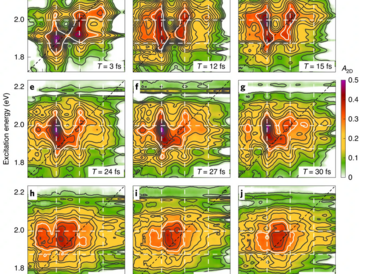Adapted from Press Release: Nr.: 68
Whether in solar cells, in photosynthesis or in the human eye: When light falls on the material, a green leaf or the retina, a transport of energy and charge occurs in certain molecules. This ultimately leads to the separation of charges and the generation of electricity. Molecular funnels, so-called conical intersections, ensure that this transport takes place in a highly efficient and directed manner. An international team led by theoretical physicist Professor Thomas Frauenheim (University of Bremen, Germany) and physicist Dr. Antonietta De Sio (University of Oldenburg, Germany) has now observed experimentally and confirmed with simulations for the first time that such conical intersections also ensure ultrafast, directed energy transport between neighboring molecules of a nanomaterial. Previously, scientists had only demonstrated this phenomenon within a molecule. The results could help in the long term to develop more efficient nanomaterials for organic solar cells, for example. The study appeared in the current issue of the journal Nature Nanotechnology.
Photochemical processes play a major role in nature and technology: when molecules absorb light, their electrons enter an excited state. This transition triggers extremely fast molecular switching processes. In the human eye, for example, the molecule rhodopsin turns in a certain way after absorbing a light particle, ultimately triggering an electrical signal - the most elementary step in the visual process.
The reason for this is the special property of rhodopsin molecules, explains Professor Christoph Lienau, head of the Ultrafast Nano-Optics group and co-author of the study: "The spinning process always proceeds in a similar way, although from a quantum mechanical point of view there are many different possibilities for the molecular motion." This is because the spinning process requires the molecule to move through a conical intersection, as a team of researchers experimentally demonstrated in the optic pigment in 2010. "This quantum mechanical mechanism works like a one-way street in the molecule: It directs the energy in a specific direction with a very high probability," Lienau explains.
The researchers led by Frauenheim and De Sio have now observed such a one-way street for electrons in a nanomaterial produced by colleagues at the University of Ulm and already used in organic solar cells. "What is special is that we have for the first time experimentally demonstrated and theoretically reproduced conical intersections between molecules lying next to each other," explains first author De Sio. Until now, physicists worldwide had only observed the quantum mechanical phenomenon within a molecule and had only speculated that conical intersections could also exist between molecules lying next to each other.
Ultrafast laser spectroscopy used
The team discovered the one-way street for electrons using ultrafast laser spectroscopy methods. In the process, the scientists illuminate the material with laser pulses that are only a few femtoseconds short. A femtosecond corresponds to one millionth of a billionth of a second. The method allows the researchers to record a kind of film of the processes that take place immediately after the light hits the material. In the process, the researchers were able to follow how electrons and atomic nuclei moved through a conical intersection.
The scientists found that a particularly strong coupling between the electrons and certain vibrational motions of the atomic nucleus helps transfer energy from one molecule to another as if on a one-way street. This is exactly what happens in the conical intersection that the researchers thus pinpoint. "In the material we studied, there were only about 40 femtoseconds between the very first optical excitation and the passage through the conical intersection," De Sio says.
To confirm their experimental observations, the Oldenburg team worked alongside theoretical physicists at the University of Bremen and other collaborators at Los Alamos National Laboratory, New Mexico, USA, and CNR-Nano, Modena, Italy. "These have clearly shown with their calculations that we have interpreted our experimental data correctly," explains De Sio.
To be sure, the researchers involved cannot yet assess in detail the exact effect and technological potential of these quantum mechanical one-way streets on nanostructures. In the long term, however, the new findings could help to better tailor materials for organic solar cells or optoelectronic components and make them significantly more efficient than before, or to develop artificial eyes from nanostructures.
Link to the publication in Nature Nanotechnology: doi.org/10.1038/s41565-020-00791-2
Constanze Böttcher
Contact:
Prof. Dr. Thomas Frauenheim
Bremen Center for Computational Materials Science (BCCMS)
Universität Bremen
Tel.: +49 421 218 62340
E-Mail: thomas.frauenheimprotect me ?!bccms.uni-bremenprotect me ?!.de
Dr. Antonietta De Sio
Universität Oldenburg
Tel.: +49 441 798-3490
E-Mail: antonietta.de.sioprotect me ?!uolprotect me ?!.de
Press release of the University of Bremen: https://www.uni-bremen.de/universitaet/hochschulkommunikation-und-marketing/aktuelle-meldungen/detailansicht/einbahnstrasse-fuer-elektronen
MAPEX Research Highlight: https://www.uni-bremen.de/mapex/forschung/research-highlights/mapex-research-highlights/intermolecular-conical-intersections-in-molecular-aggregates


